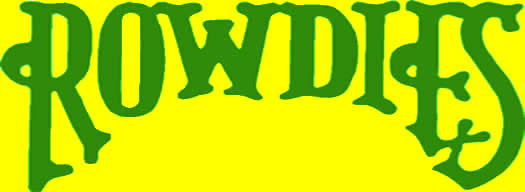
Welcome
to the Official Site of the
Tampa
Bay Rowdies!
They came to the west coast of Florida from around the world, both from cities large and small.
They came with pale white bodies devoid of suntans, with accents largely unheard of before, and sometimes barely understandable dialects.
More than 30 years ago, when the Tampa Bay area was nothing more than a medium-sized American city and tourism had yet to grow into the product it is today, professional sports were only a dream.
Then came the North American Soccer League and with them came the Tampa Bay Rowdies.
They came into an area starving for professional sports. There was no National Football League franchise. There was no National Hockey League franchise. There was no Arena Football League Tampa Bay franchise.
No, the Rowdies became the forerunners of professional sports and they became a success drawing athletes from worldly destinations like England, Scotland, South Africa, Bermuda, Haiti, Costa Rica and Italy.
They came because a Philadelphia Main Line kind of guy named George Strawbridge, was savvy enough to see the potential the area offered for Futebol, a.k.a. soccer, was limitless.
With him, Strawbridge brought a bright, captivating advertising campaign that put the Rowdies on the minds of all sports fans, not only on the west coast of Florida, but also in the NASL and eventually those in Europe.
The Rowdies were unlike anything sports had seen hereabouts. They made public appearances in malls or schools, anywhere they could to preach the gospel of football.
"They cut a record that made everyone sing along and it went thusly:
The Rowdies run here, the Rowdies run there
They kick the ball around.
The Rowdies run here, the Rowdies run there
Then they fall on the ground.
Oh, the Rowdies, oh the Rowdies, the Rowdies are
a kick in the grass."
Yes, the Rowdies were not only a kick in the grass, they became household names, as much for their on-and-off the field joie de vivre’ as their nicknames.
They were as distinctive as the green-and-gold uniforms and certainly as distinctive as the song.
There was a ‘Golden Turkey’, a nickname given first coach Eddie Firmani in his playing days because of his aloof natural after scoring goals in Italy.
There was a guy name ‘Jaws’ long before Peter Benchly immortalized a mechanical shark in a movie. Mark Lindsay was always ‘jawing’ on and off the field at opponents and friends alike. Never quiet, Lindsay’s ‘bite’ on the field produced hard, don’t-forget-me tackles.
There was the gangly, reed-thin ‘Stork’, Derek Smethurst, who only scored goals in bunches as well as ‘Big Foot’, Haitian Arsene Auguste, who scored the club’s winning goal in the 1975 Soccer Bowl, but whose smile lit up a room and whose bone-jarring tackles made forwards fear him more than anything else.
‘Captain Rowdie’, a barrel-chested midfielder named John Boyle who had legs as white as snow and hair as thin as a wheat crop during a summer drought, became the role model for the club, as much as because of his leadership as well as the fact that he knocked opponents ass-over-tea kettle when they came his way.
Then there was ‘Iron Mike.’ He was a baby-faced kid from South Africa who built a reputation as an NASL all-star defender by playing every minute of every game and doing it against the best the league had to offer.
Future teams had a ‘Clown Prince’ (Rodney Marsh), a ‘Cage’ (goalkeeper Paul Hammond and a host of other characters.
You can have all the nicknames and characters you want but if you don’t win, it doesn’t matter in professional sports.
This was a team that won and won and won and won. The Rowdies built a reputation for excellence on the field, taking good value players and melding the right chemistry to produce contending teams which won outdoor titles, played in the finals numerous years, and captivated fans – and titles – indoors also.
Outside of the glamour boys in New York – the rich and worldly Cosmos – the Rowdies became a model of what a successful NASL franchise should be.
That translated into putting fans – they were called ‘fannies’ – in the stands at the now razed Tampa Stadium.
The ‘fannies’ sat through scorching heat, starry nights, and ear-splitting thunder, lightning and monsoon rains to cheer their lads to victory.
Fans flocked to the stadium, averaging more than 30,000 a game in the early years and more thereafter. For big games against rivals like the Cosmos or the Fort Lauderdale Strikers the Rowdies often drew many more than that.
Fans came to see past World Cup stars like Brazil’s greatest export ever, Pele, as well as German World Cup Captain Franz Beckenbauer, who made his U.S. debut at Tampa stadium before a sellout crowd in excess of 60,000, a game that was televised in Germany and around many parts of Europe.
Along the way world class players like Gordon Banks, Alan Ball, Ace Ntsoelengue, Karl-Heinz Granitza, George Best, Johan Cruyff, Bobby Moore, Giorgio Chinaglia, Eusebio, Trevor Francis, Steve Hunt, Teofilo Cubillas, Gerd Mueller and he like were Tampa Stadium performers, too.
As interest grew through the years, soccer became more ‘worldly’ with international ‘friendlies.’
Famed Manchester United of England made a Tampa appearance. So did teams from Russia (Moscow Dynamo, Zenit-Leningrad), Italy (Roma FC), and a first-ever team from the People’s Republic of China in 1977.
All that propagated the Rowdies ‘aura’ around the world and expanded the knowledge of soccer fans in central Florida.
The nine-year lifespan of the NASL (1975-84) remains fond memories to 40- and 50-years old living in the bay area even today.
More than a dozen Rowdie players make their homes in the area. They embraced the community so well – and the community embraced them as well back – that they chose to stay and made new careers in business. They have also raised families here as well.
Those players continue to work in area soccer leagues, teaching second-generation children of their fans of the 70s and 80s.
And while the glory of their accomplishments on the field lives on in print and videotape, the essence of their legacy has a breathing, eating, talking life of its own every day.
Everywhere you look around the bay area, from as far south as Sarasota to as far north as Pasco County and as far west as the brilliant beaches of Clearwater to the farmlands of Lakeland, kids continue to play soccer and fall in love with the game.
That, after all, is the greatest legacy the Tampa Bay Rowdies have left behind. This website is their story. Enjoy.
Words by our friend Dick Mudry. After more than 20 years at the Tampa Tribune, where he spent endless hours on the road with the Rowdies watching their play on and off the field, Dick returned to his true love - golf - and has since traveled the world watching the greats of the game on every stage imaginable. Now an independent media consultant, Mudry has been a public relations consultant to a variety of golf tournaments and companies, written the high profile leather-bound Masters Annual for Augusta National Golf Club, and kept himself busy by writing free lance stories for a variety of national golf magazines. You can reach Dick at Rmudry947@aol.com
